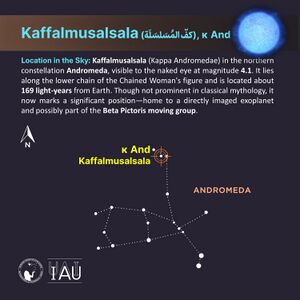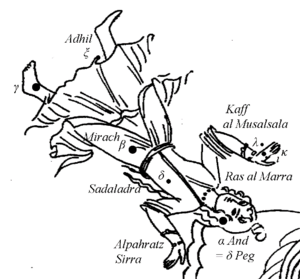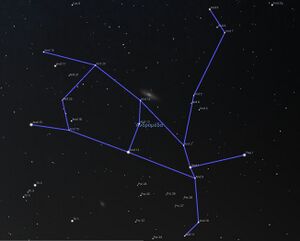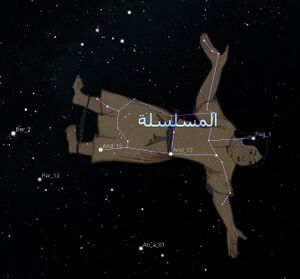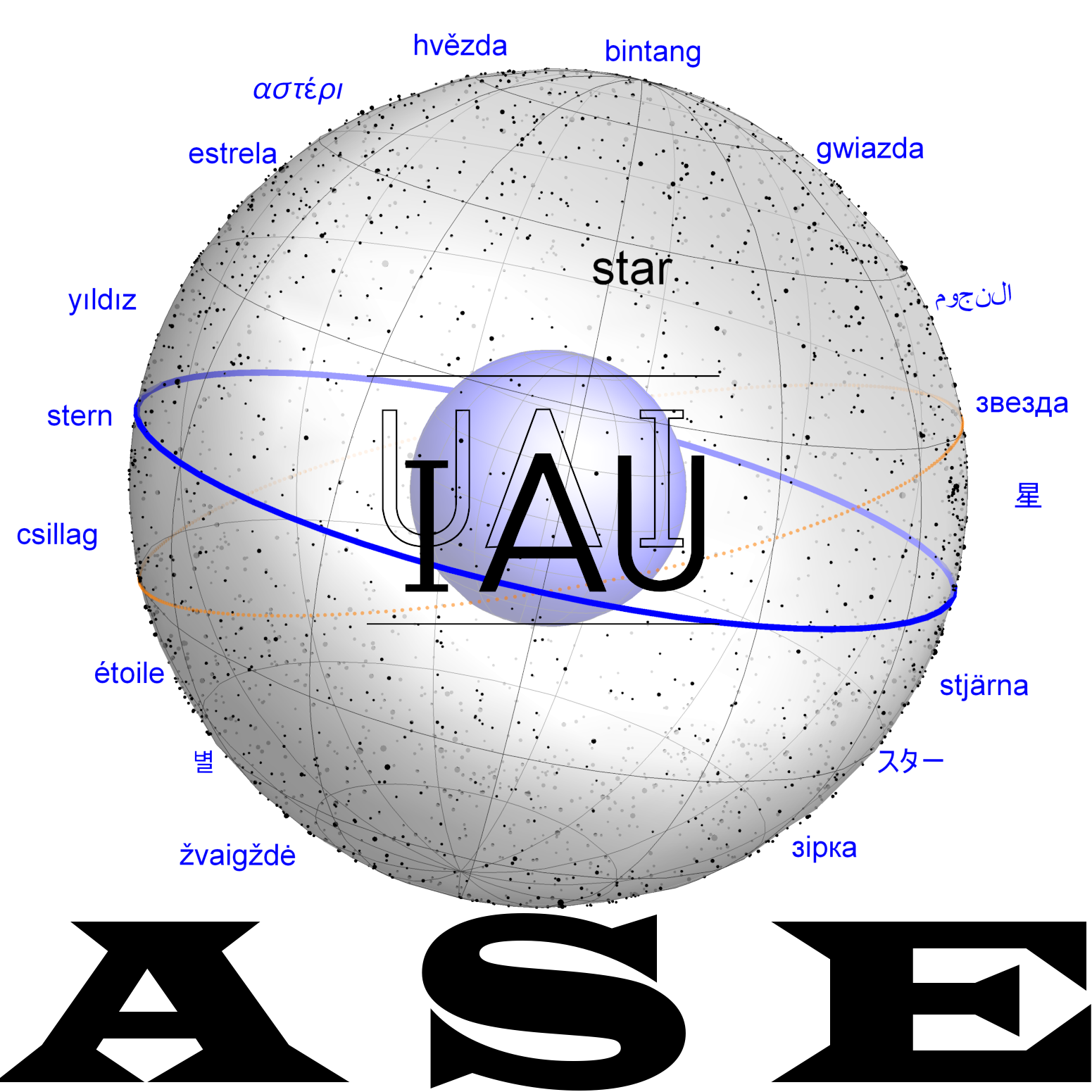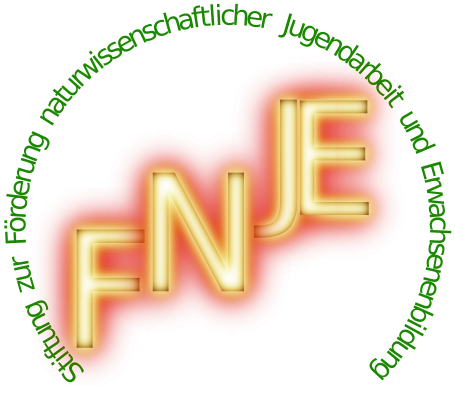Kaffalmusalsala (كفّ المسلسة)
The asterism formed by the three stars ι, κ and λ Andromedae is called "Andromeda's right hand" in ancient Greek texts and their derivatives. One of the Arabic translations is Kaff al-Musalsala /كفّ المسلسة. Herein, al Musalala is from the translation "The Chained Woman" in Isḥāq and al-Ṣūfī and "Kaff" is for the hand. The variant Keff al Salsalat is given in Knobel (1895).[1]
Kaffalmusalsala is a modern star name adopted by the International Astronomical Union in the IAU-Catalog of Star Names (IAU-CSN) for HIP 116805 (κ And, HR 8976) in constellation And.
Etymology and History
Hand of Andromeda in the Almagest
| Greek
(Heiberg 1894)[2] |
transliteration of Greek | English
(Toomer 1984)[3] |
identification
(Toomer 1984) | |
|---|---|---|---|---|
| 7 | τῶν ἐπὶ τοῦ δεξιοῦ ἀκροχείρου γ ὁ νότιος | (toon epi toy dexioy akrocheiroy 3 ho notios) | The southernmost of the 3 stars on the right band | ι And |
| 8 | ὁ μέσος αὐτῶν | (ho mesos aytoon) | The middle one of these | κ And |
| 9 | ὁ βόρειος τῶν τριῶν | (ho boreios toon trioon) | The northernmost of the three | λ And |
| 23 | ὁ ἐκτὸς καὶ προηγούμενος τῶν ἐν τῷ δεξιῷ ἀκροχείρῳ γ | (ho hektos kai proegoymenos toon hen too dexioo akrocheiroo 3) | The star in advance of the three in the right hand, outside [ of it] | ο And |
Andromeda in Arabic texts[4]
- Ἀνδρομέδα > Andrūmāḏā (Isḥāq),
- Andrūmīḏā (Ṣūfī),
- al-Mar’a, the Wife (Ḥağğāğ),
- al-Mar’at al-latī lam tara baclan, the Woman who has no husband (Battānī, Ṣūfī),
- al-Mar’at al-Musalsala, the Chained Woman (Isḥāq, Ṣūfī)
Hand of Andromeda
Andromeda's right arm has always been drawn in the area of the sky with this asterism (until Bode's new invention of the constellation Honores Friderici in 1795).
Spelling Variants:
- Keff al Salsalat,
- or Keffalsalsalat in Al-Aḫsāsī[5] from Latin transliteration "Manus Catenatae", used for iota Andromedae (ι And).
Transformation from the Greek to Arabic:
The star ι And is described as Τῶν ἐπἰ τοῦ δεξιοῦ άκρόχειρον (Halma, II, 48-49), i.e. "at the end of the right hand" together with κ and λ And.
In Arabic,[6] al-Ḥağğāğ translates as clā ṭaraf al-kaff, “at the tip of the right palm” and Isḥāq as clā ’l-kaff, “on the palm”. Al-Battānī does not mention these stars. As for al-Ṣūfī, he uses also the word al-Kaff in their description, and al-Bīrūnī does the same after him.
Then the following identifications appear chronologically:[7]
| Arabic | English | Author | star | ||
|---|---|---|---|---|---|
| al-Awsaṭ min Kaff al-Musalsala | the Median of the Palm of the Chained One | Marrākušī (13th c) | κ And | ||
| Wasaṭ Kaff al-Musalsala | the Median of the Palm of the Chained One | Miṣrī (14th c.) | κ And | ||
| idem | Idem | Tīzīnī (16th c.) | κ And | ||
| Šamālī Kaff al-Musalsala | The Northern of the Palm of the Chained One | Miṣrī(14th c.) | λ And | ||
Only this one can be taken as a true proper name:
| Arabic | English | Author | star | ||
|---|---|---|---|---|---|
| Kaff al-(Mu)salsala | the Palm of the Chain One | Aḫsāsī (17th) | ι And | ||
Nota bene :
Keff-i müselsele is indicated for κ And by Mustafa Pultar[8], name taken in the form Kaff al Musalsala by Roland Laffitte in Nommer les étoiles500 noms hérités des Arabes (2025), 323.
Remarks.
- al-Aḫsāsī reads al-salasa in the manuscript, which is, as he quotes it (p. 436, n. 31), a scribal error for al-musalsala, "the Chained One." It seems reasonable to reintroduce the exact word.
- In the transcription currently used, we write kaff and no longer keff, and the final /t/ of Salsalat is not justified. The name would therefore be Kaff al-Musalsala, which is roughly the spelling used by Mustafa Pular in his catalog for κ And.
- The stars ι, κ and λ And all three deserve the name Kaff al-musalsala, but their magnitudes are respectively: 4.29, 4.15, and 3.81. As we can see, λ And is the largest.
Mythology
see Andromeda
IAU Working Group on Star Names

The name "Keffalsalsalat" was suggested to the IAU WGSN in 2023 due to its appearance in modern literature (Knobel 1895). The name is not in Simbad or anyhow known in the public. From the group of three, Lambda would be the brightest, but has an older name (Asīdu); so we would suggest the second brightest, Kappa Andromedae (κ And), to be named with the Arabic term. However, we suggest to correct Knobel's spelling from the 19th century and name the star Kaffalmusalsala (كفّ المسلسة) (adapted to the IAU-Style Guide, simplified to pre-Unicode ASCII).
| identification
(Toomer 1984) |
HR | HIP | type | Vmag | binary? | exoplanets? |
|---|---|---|---|---|---|---|
| ι And | 8965 | 116631 | pulsating variable,
B8 V |
4.29 | no | |
| κ And | 8976 | 116805 | high proper motion star
B9 IVn |
4.14 | yes
(one companion, 13 MJup, could also be super-Jupiter planet or a brown dwarf) | |
| λ And | 8961 | 116584 | RS CVn Variable
G8 IVk |
3.82 | ||
| ψ And | 9003 | 117221 | G3 Ib-II | 4.966 | double or multiple | |
| ο And | 8762 | 113726 | Be Star
B6 IV/V_sh |
3.62 | no | |
IAU Working Group on Star Names
The name was adopted by the IAU WGSN on 2025/05/08. The WGSN chose to adopt the name "Kaffalmusalsala" for κ And in the IAU-CSN.
Weblinks
- Website of the IAU WGSN: https://exopla.net/
Reference
- References (general)
- References (early modern)
- Ian Ridpath's website (Star Tales – Andromeda )
- ↑ Knobel, E.B. (1895). On a Catalogue of Stars in the Calendarium of Mohammad Al Achsasi Al Mouakket. MNRAS, 55, 429K (online)
- ↑ Claudii Ptolemaei Syntaxis Mathematica, ed. Heiberg, J.L., Teubner Verlagsgesellschaft, Leipzig 1898
- ↑ Ptolemy’s Almagest, Engl. translation by Toomer, G.J., Princeton Uni. Press, 1998, Orig.: London, 1984
- ↑ Roland Laffitte, Catalogue of the Greco-Arabian Sky (2025), 23.
- ↑ E. B. Knobel (1895, MNRAS, 55, 429) "On a Catalogue of Stars in the Calendarium of Mohammad Al Achsasi Al Mouakket" (17th century, Arabic, from Cairo)
- ↑ Roland Laffitte in Nommer les étoiles500 noms hérités des Arabes (2025), 323
- ↑ Roland Laffitte, Catalogue of the Greco-Arabian Sky (2025), 23.
- ↑ Mustafa Pultar, Yıldız Adları Sözlüğü / Dictionary of Star Names, Stanbul, 2010.

